
Am Fam Physician. 2011;84(5):527-536
A more recent article on orthostatic hypotension is available.
Patient information: See related handout on orthostatic hypotension, written by the authors of this article.
Author disclosure: No relevant financial affiliations to disclose.
The opinions and assertions contained herein are the private views of the authors and are not to be construed as official or as reflecting the views of the U.S. Army Medical Department or the U.S. Army Service at large.
Orthostatic hypotension is defined as a decrease in systolic blood pressure of 20 mm Hg or a decrease in diastolic blood pressure of 10 mm Hg within three minutes of standing when compared with blood pressure from the sitting or supine position. It results from an inadequate physiologic response to postural changes in blood pressure. Orthostatic hypotension may be acute or chronic, as well as symptomatic or asymptomatic. Common symptoms include dizziness, lightheadedness, blurred vision, weakness, fatigue, nausea, palpitations, and headache. Less common symptoms include syncope, dyspnea, chest pain, and neck and shoulder pain. Causes include dehydration or blood loss; disorders of the neurologic, cardiovascular, or endocrine systems; and several classes of medications. Evaluation of suspected orthostatic hypotension begins by identifying reversible causes and underlying associated medical conditions. Head-up tilt-table testing can aid in confirming a diagnosis of suspected orthostatic hypotension when standard orthostatic vital signs are nondiagnostic; it also can aid in assessing treatment response in patients with an autonomic disorder. Goals of treatment involve improving hypotension without excessive supine hypertension, relieving orthostatic symptoms, and improving standing time. Treatment includes correcting reversible causes and discontinuing responsible medications, when possible. Nonpharmacologic treatment should be offered to all patients. For patients who do not respond adequately to nonpharmacologic treatment, fludrocortisone, midodrine, and pyridostigmine are pharmacologic therapies proven to be beneficial.
Orthostatic hypotension is defined as a decrease in systolic blood pressure of 20 mm Hg or a decrease in diastolic blood pressure of 10 mm Hg within three minutes of standing compared with blood pressure from the sitting or supine position. Alternatively, the diagnosis can be made by head-up tilt-table testing at an angle of at least 60 degrees.1 Orthostatic hypotension is often found in older patients and in those who are frail.2 It is present in up to 20 percent of patients older than 65 years.3 In one study, the prevalence of orthostatic hypotension was 18 percent in patients older than 65 years, but only 2 percent of these patients were symptomatic.3
In the absence of volume depletion, younger patients with orthostatic hypotension usually have chronic autonomic failure. A related problem, postprandial hypotension, is common in older patients and those with autonomic dysfunction. In postprandial hypotension, there is a decrease in systolic blood pressure of at least 20 mm Hg within 75 minutes of a meal.4
| Clinical recommendation | Evidence rating | References |
|---|---|---|
| Consider head-up tilt-table testing in patients with symptoms of orthostatic hypotension despite normal vital signs, or in patients who are unable to stand for orthostatic vital sign measurements. | C | 6, 14 |
| Patients with chronic orthostatic hypotension should be counseled to avoid large carbohydrate-rich meals, limit alcohol intake, and ensure adequate hydration. | C | 6, 22 |
| Fludrocortisone, midodrine, and pyridostigmine (Mestinon) are effective therapies for chronic orthostatic hypotension. | B | 26, 28, 29 |
Pathophysiology
A normal hemodynamic response to changes in posture requires normal function of the cardiovascular and autonomic nervous systems. Standing results in blood pooling of approximately 500 to 1,000 mL in the lower extremities and splanchnic circulation. This initiates an increase in sympathetic outflow, which increases peripheral vascular resistance, venous return, and cardiac output, thereby limiting the decrease in blood pressure.
These compensatory mechanisms result in a decrease in systolic blood pressure (5 to 10 mm Hg), an increase in diastolic blood pressure (5 to 10 mm Hg), and an increase in pulse rate (10 to 25 beats per minute). However, orthostatic hypotension may result if there is inadequate intravascular volume, autonomic nervous system dysfunction, decreased venous return, or inability to increase cardiac output in response to postural changes.5 Decreased cerebral perfusion produces the neurologic symptoms of orthostatic hypotension.5
Clinical Presentation and Evaluation
Orthostatic hypotension may be acute or chronic. Patients may present with light-headedness, blurred vision, dizziness, weakness, and fatigue, or with syncope (in the acute care setting).6 Less commonly, they may present with neck and shoulder pain, orthostatic dyspnea, and chest pain.7 Table 1 outlines the differential diagnosis of orthostatic hypotension, which may be caused by a number of things, including dehydration, blood loss, medication, or a disorder of the neurologic, cardiovascular, or endocrine system.8–10 Evaluation of suspected orthostatic hypotension begins by identifying reversible causes and underlying associated medical conditions. Table 2 lists historical features that suggest a specific diagnosis in the patient with orthostatic hypotension.7,8 In addition to assessing for symptoms of orthostasis, the physician should elicit symptoms of autonomic dysfunction involving the gastrointestinal and genitourinary systems.7
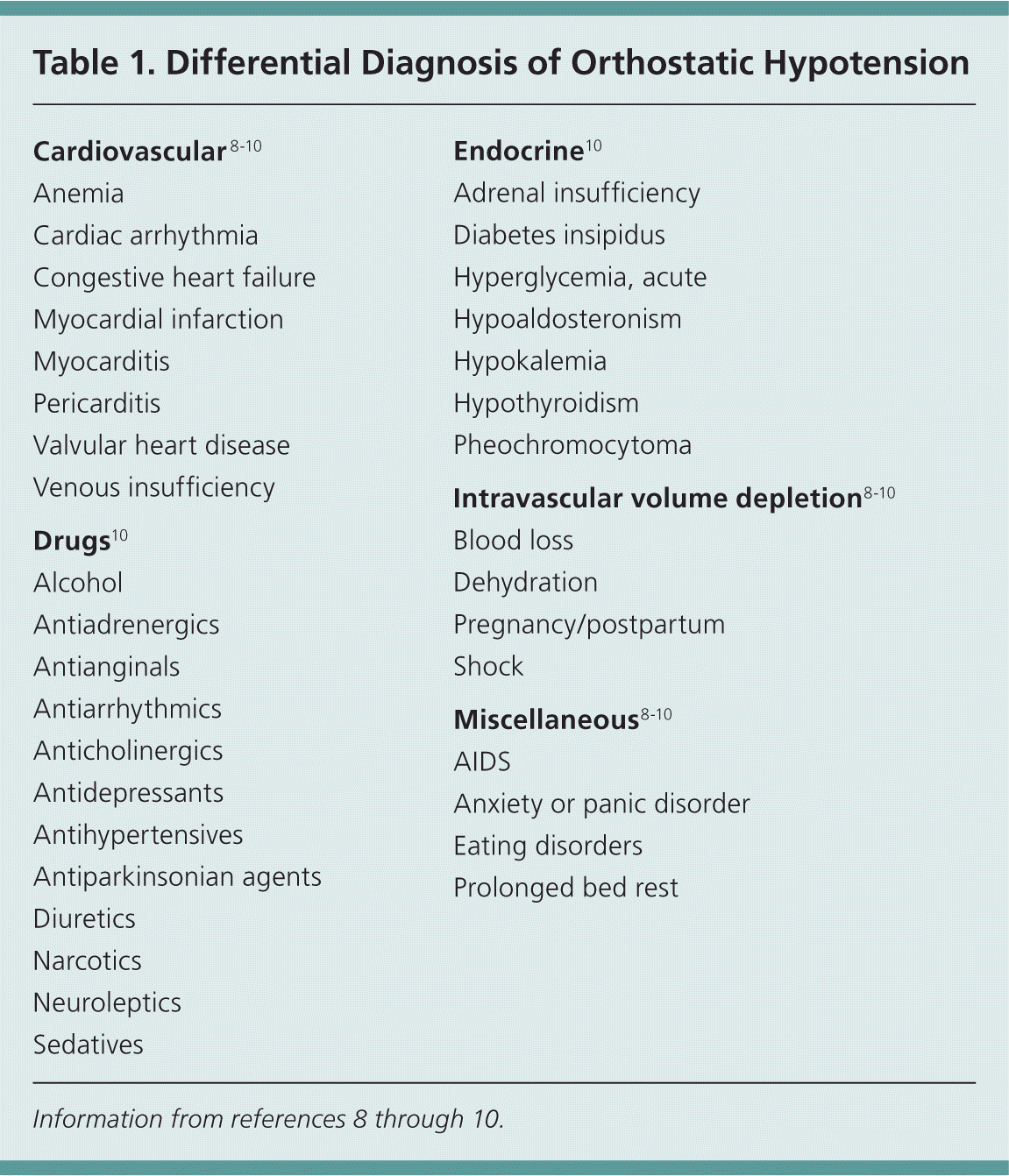
| Cardiovascular8–10 |
| Anemia |
| Cardiac arrhythmia |
| Congestive heart failure |
| Myocardial infarction |
| Myocarditis |
| Pericarditis |
| Valvular heart disease |
| Venous insufficiency |
| Drugs10 |
| Alcohol |
| Antiadrenergics |
| Antianginals |
| Antiarrhythmics |
| Anticholinergics |
| Antidepressants |
| Antihypertensives |
| Antiparkinsonian agents |
| Diuretics |
| Narcotics |
| Neuroleptics |
| Sedatives |
| Endocrine10 |
| Adrenal insufficiency |
| Diabetes insipidus |
| Hyperglycemia, acute |
| Hypoaldosteronism |
| Hypokalemia |
| Hypothyroidism |
| Pheochromocytoma |
| Intravascular volume depletion8–10 |
| Blood loss |
| Dehydration |
| Pregnancy/postpartum |
| Shock |
| Miscellaneous8–10 |
| AIDS |
| Anxiety or panic disorder |
| Eating disorders |
| Prolonged bed rest |
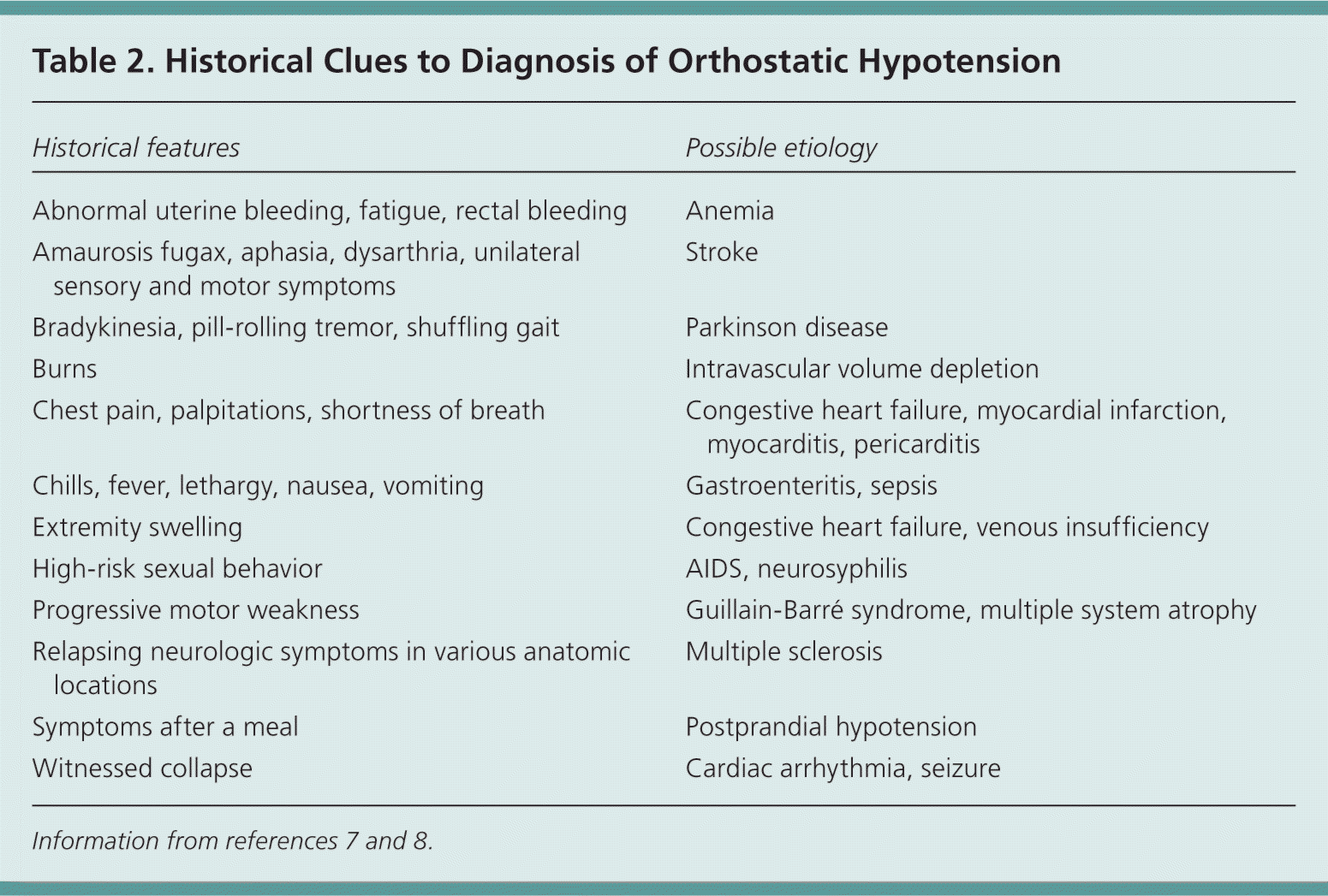
| Historical features | Possible etiology |
|---|---|
| Abnormal uterine bleeding, fatigue, rectal bleeding | Anemia |
| Amaurosis fugax, aphasia, dysarthria, unilateral sensory and motor symptoms | Stroke |
| Bradykinesia, pill-rolling tremor, shuffling gait | Parkinson disease |
| Burns | Intravascular volume depletion |
| Chest pain, palpitations, shortness of breath | Congestive heart failure, myocardial infarction, myocarditis, pericarditis |
| Chills, fever, lethargy, nausea, vomiting | Gastroenteritis, sepsis |
| Extremity swelling | Congestive heart failure, venous insufficiency |
| High-risk sexual behavior | AIDS, neurosyphilis |
| Progressive motor weakness | Guillain-Barré syndrome, multiple system atrophy |
| Relapsing neurologic symptoms in various anatomic locations | Multiple sclerosis |
| Symptoms after a meal | Postprandial hypotension |
| Witnessed collapse | Cardiac arrhythmia, seizure |
Key physical examination findings in the evaluation of suspected orthostatic hypotension are listed in Table 3.11,12 A detailed assessment of the motor nervous system should be performed to evaluate for signs of Parkinson disease, as well as cerebellar ataxia.7 Blood pressure and pulse rate should be measured in the supine position and repeated after the patient has been standing for three minutes. As many as two-thirds of patients with orthostatic hypotension may go undetected if blood pressure is not measured while supine.13 However, a retrospective review of 730 patients found that orthostatic vital signs had poor test characteristics (positive predictive value = 61.7 percent; negative predictive value = 50.2 percent) when compared with tilt-table testing for the diagnosis of orthostatic hypotension.14 Head-up tilt-table testing should be ordered if there is a high index of suspicion for orthostatic hypotension despite normal orthostatic vital signs, and it may be considered in patients who are unable to stand for orthostatic vital sign measurements.6,14
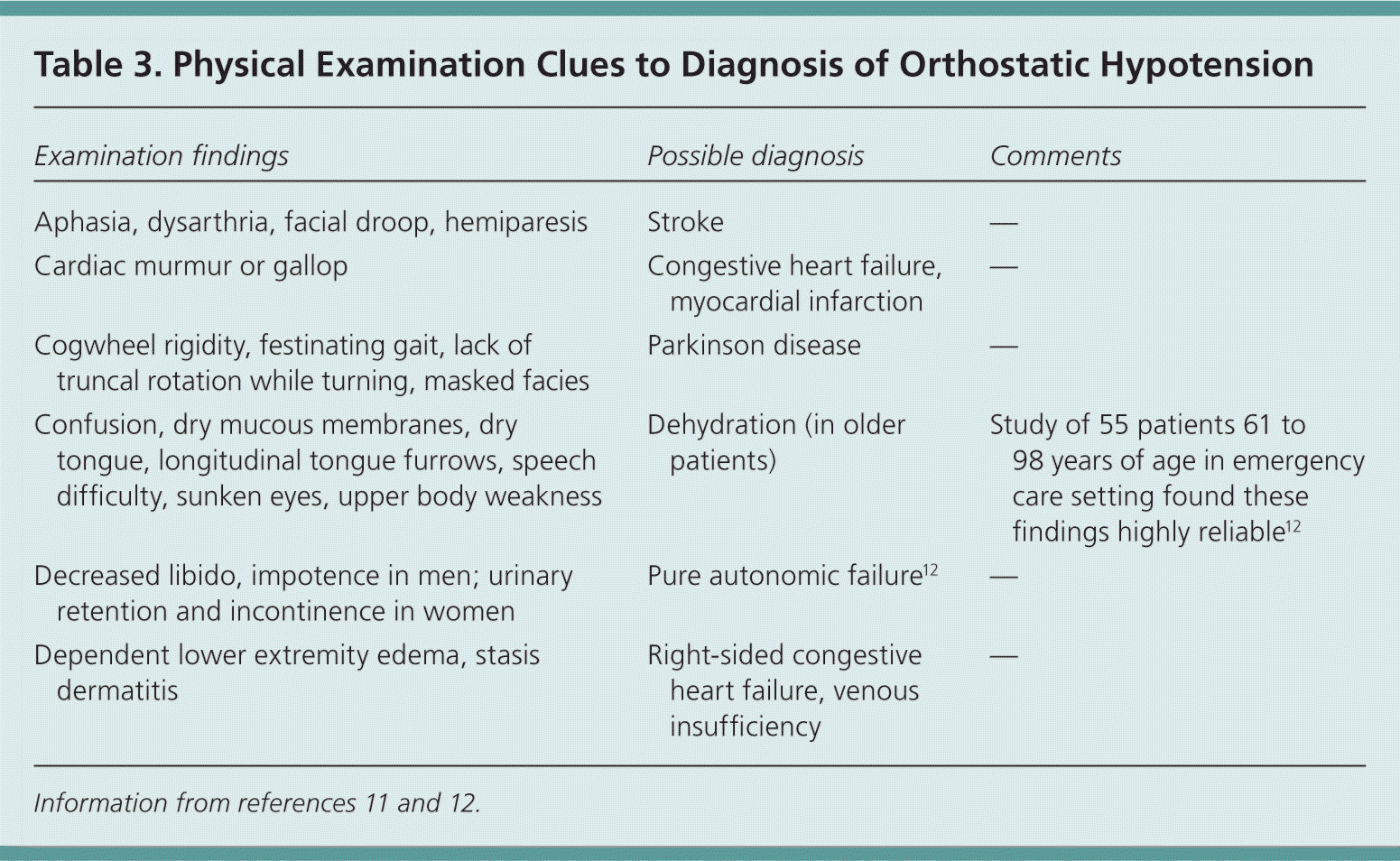
| Examination findings | Possible diagnosis | Comments |
|---|---|---|
| Aphasia, dysarthria, facial droop, hemiparesis | Stroke | — |
| Cardiac murmur or gallop | Congestive heart failure, myocardial infarction | — |
| Cogwheel rigidity, festinating gait, lack of truncal rotation while turning, masked facies | Parkinson disease | — |
| Confusion, dry mucous membranes, dry tongue, longitudinal tongue furrows, speech difficulty, sunken eyes, upper body weakness | Dehydration (in older patients) | Study of 55 patients 61 to 98 years of age in emergency care setting found these findings highly reliable12 |
| Decreased libido, impotence in men; urinary retention and incontinence in women | Pure autonomic failure12 | — |
| Dependent lower extremity edema, stasis dermatitis | Right-sided congestive heart failure, venous insufficiency | — |
A description of head-up tilt-table testing and its indications are outlined in Table 4,6,9 and Figure 1 shows a patient undergoing the testing. The procedure is generally considered safe, but serious adverse events such as syncope and arrhythmias have been reported. All staff involved in performing tilt-table testing should be trained in advanced cardiac life support, and resuscitation equipment should be readily available.6 Four common abnormal patterns can be seen in response to tilt-table testing (Table 5).15 The test may be useful in distinguishing orthostatic hypotension from other disorders that can present with symptoms of orthostasis, such as neurocardiogenic syncope.7 Sensitivity of tilt-table testing for diagnosing neurocardiogenic syncope is as high as 65 percent, and specificity is as high as 100 percent.15
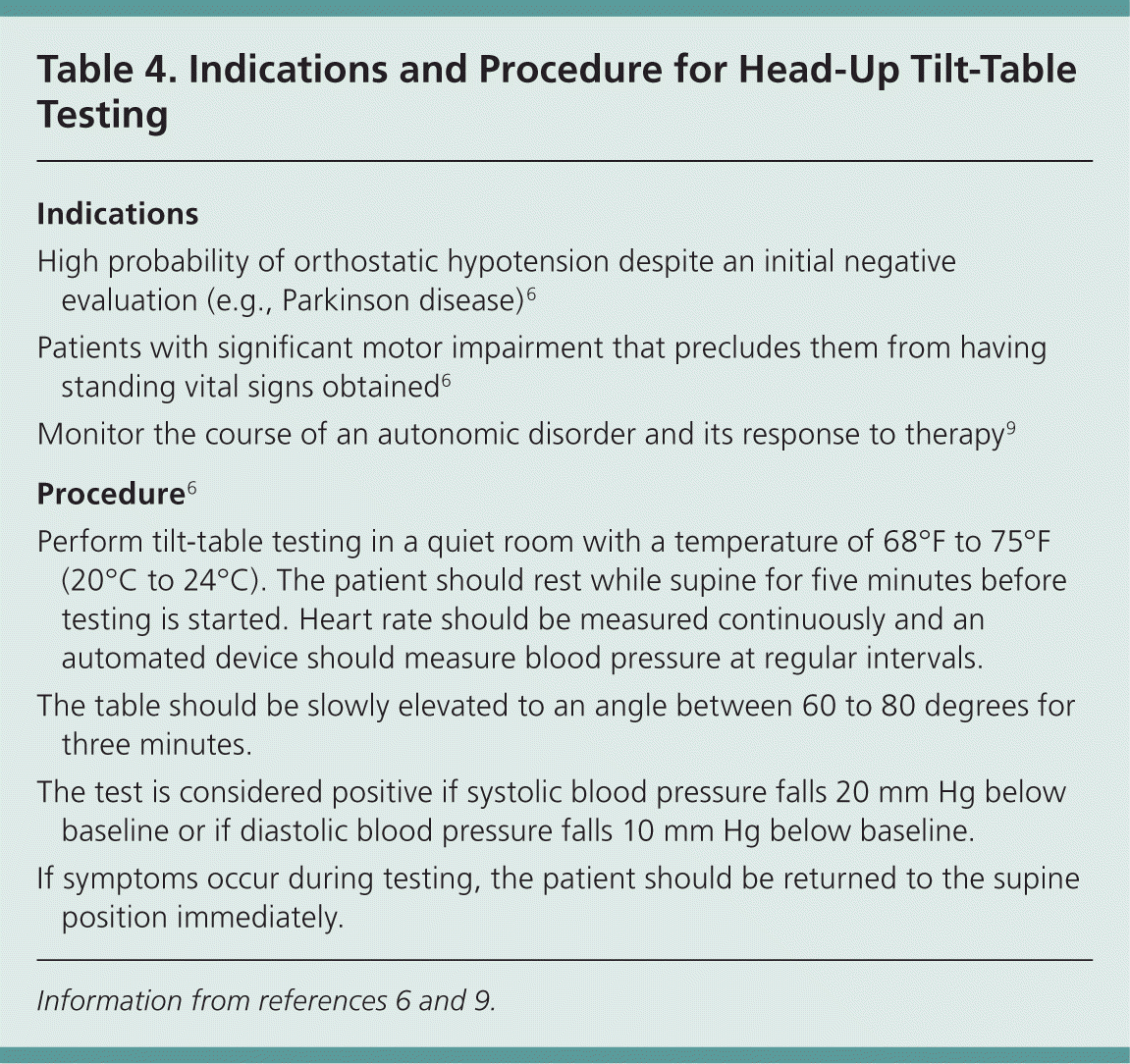
| Indications |
| High probability of orthostatic hypotension despite an initial negative evaluation (e.g., Parkinson disease)6 |
| Patients with significant motor impairment that precludes them from having standing vital signs obtained6 |
| Monitor the course of an autonomic disorder and its response to therapy9 |
| Procedure6 |
| Perform tilt-table testing in a quiet room with a temperature of 68°F to 75°F (20°C to 24°C). The patient should rest while supine for five minutes before testing is started. Heart rate should be measured continuously and an automated device should measure blood pressure at regular intervals. |
| The table should be slowly elevated to an angle between 60 to 80 degrees for three minutes. |
| The test is considered positive if systolic blood pressure falls 20 mm Hg below baseline or if diastolic blood pressure falls 10 mm Hg below baseline. |
| If symptoms occur during testing, the patient should be returned to the supine position immediately. |
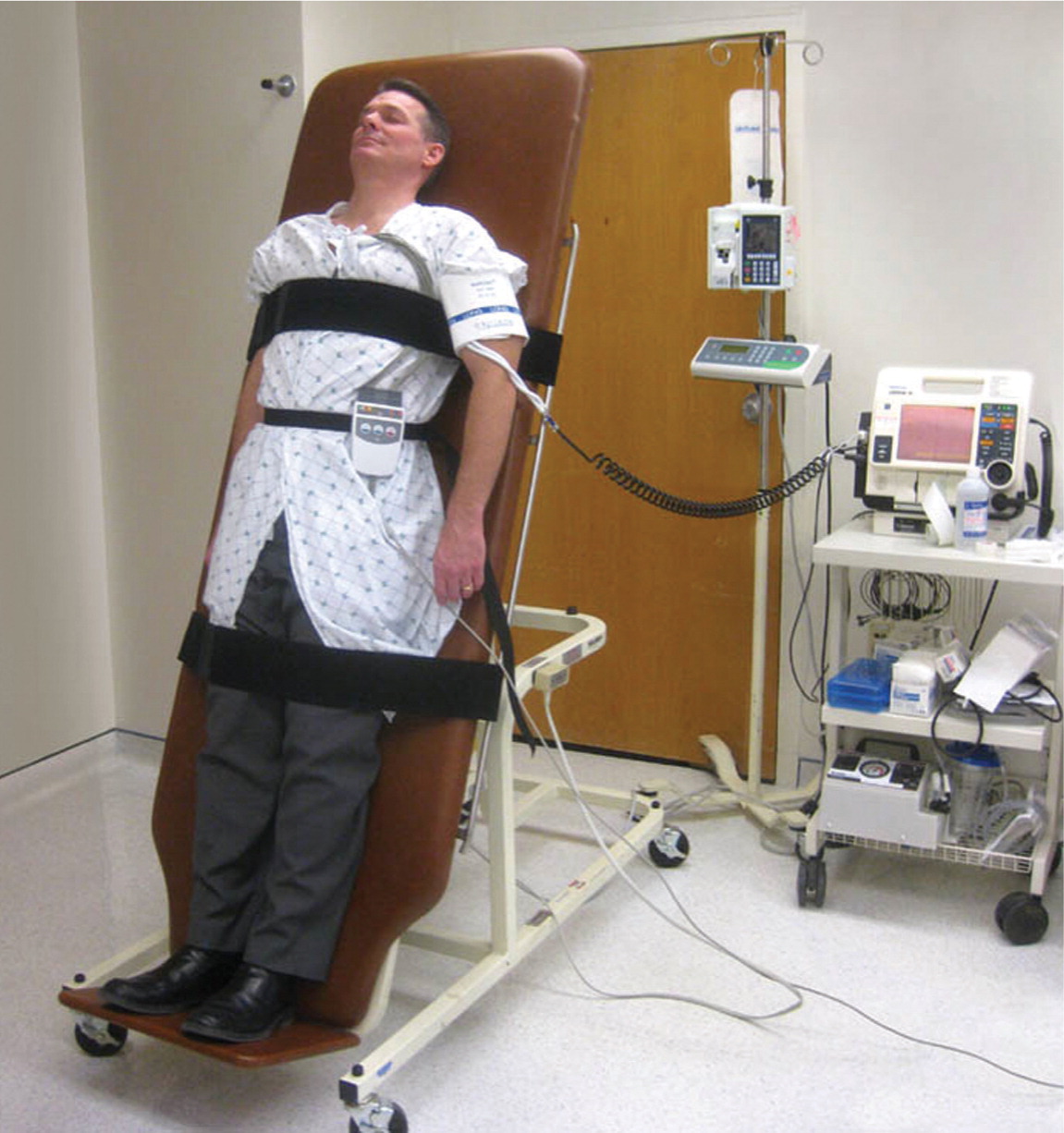
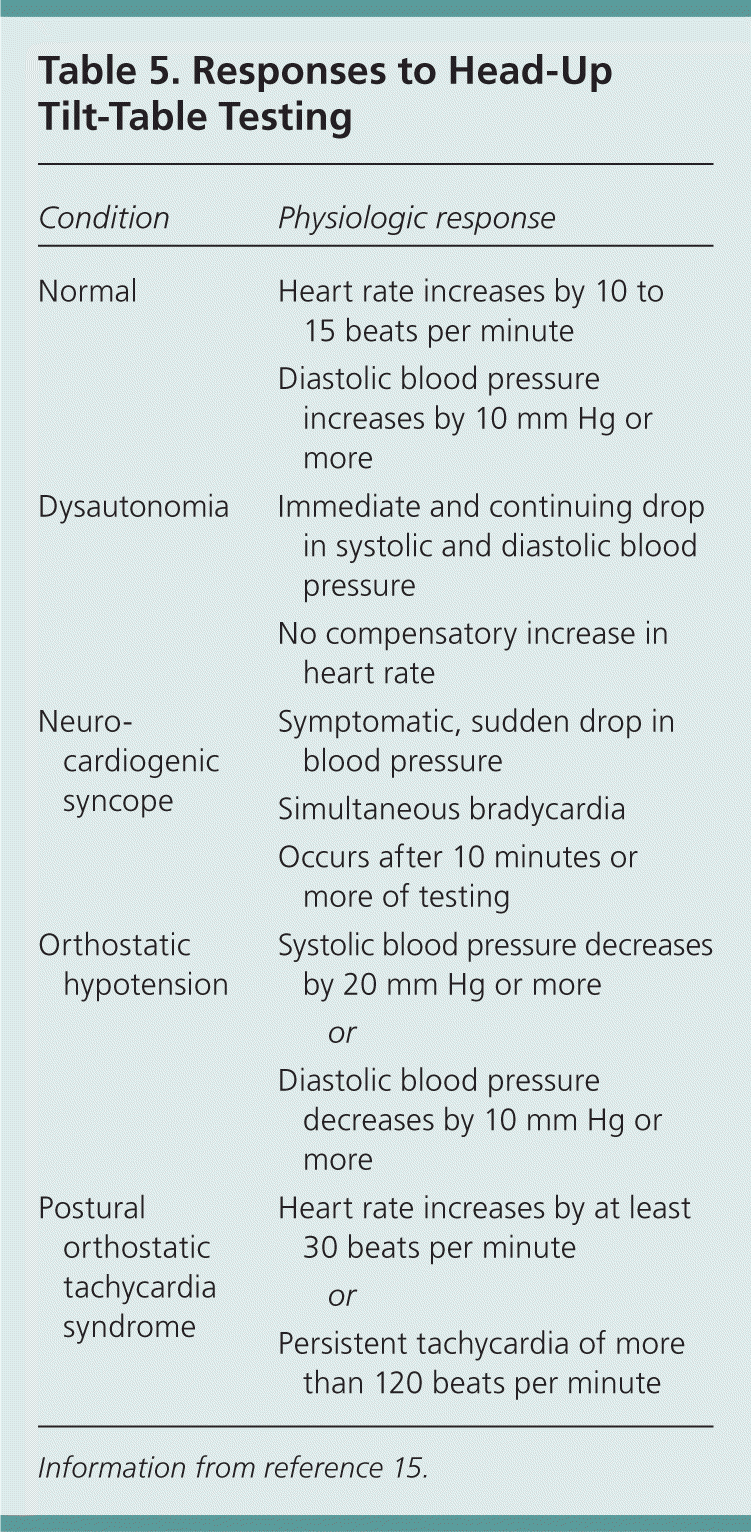
| Condition | Physiologic response | |
|---|---|---|
| Normal | Heart rate increases by 10 to 15 beats per minute | |
| Diastolic blood pressure increases by 10 mm Hg or more | ||
| Dysautonomia | Immediate and continuing drop in systolic and diastolic blood pressure | |
| No compensatory increase in heart rate | ||
| Neurocardiogenic syncope | Symptomatic, sudden drop in blood pressure | |
| Simultaneous bradycardia | ||
| Occurs after 10 minutes or more of testing | ||
| Orthostatic hypotension | Systolic blood pressure decreases by 20 mm Hg or more | |
| or | ||
| Diastolic blood pressure decreases by 10 mm Hg or more | ||
| Postural orthostatic tachycardia syndrome | Heart rate increases by at least 30 beats per minute | |
| or | ||
| Persistent tachycardia of more than 120 beats per minute | ||
Certain patients may not present with classic historical features of orthostatic hypotension. In older patients, a report of dizziness upon standing may not correlate with the finding of orthostatic hypotension. A prospective study of older women found that use of anxiolytics or sleeping aids once weekly and cigarette smoking were more closely associated with postural dizziness without orthostatic hypotension than with a finding of orthostatic hypotension on tilt-table testing.16 In patients with Parkinson disease, classic symptoms of orthostatic hypotension are not reliably present in those who have autonomic dysfunction.17,18 A study of 50 patients with Parkinson disease found that only one-half of the patients who developed orthostatic hypotension during tilt-table testing were symptomatic.17 The study also found that patients with Parkinson disease who undergo tilt-table testing may need to be tested for longer than the recommended three minutes because only nine of 20 patients who developed orthostatic hypotension did so within three minutes. Extending the test to 11 minutes resulted in 15 of 20 patients being diagnosed, whereas 29 minutes was necessary to detect orthostatic hypotension in all patients.17
ACUTE CARE SETTING
In acute care settings (Figure 2), syncope may be the initial presentation of orthostatic hypotension. A prospective study of 611 patients presenting to an emergency department following a syncopal episode found that 24 percent had orthostatic hypotension.19 Patients with syncope should be admitted if they have known cardiovascular disease, associated chest pain, an abnormal electrocardiogram, suspected pulmonary embolism, or new cardiovascular or neurologic findings on examination.20
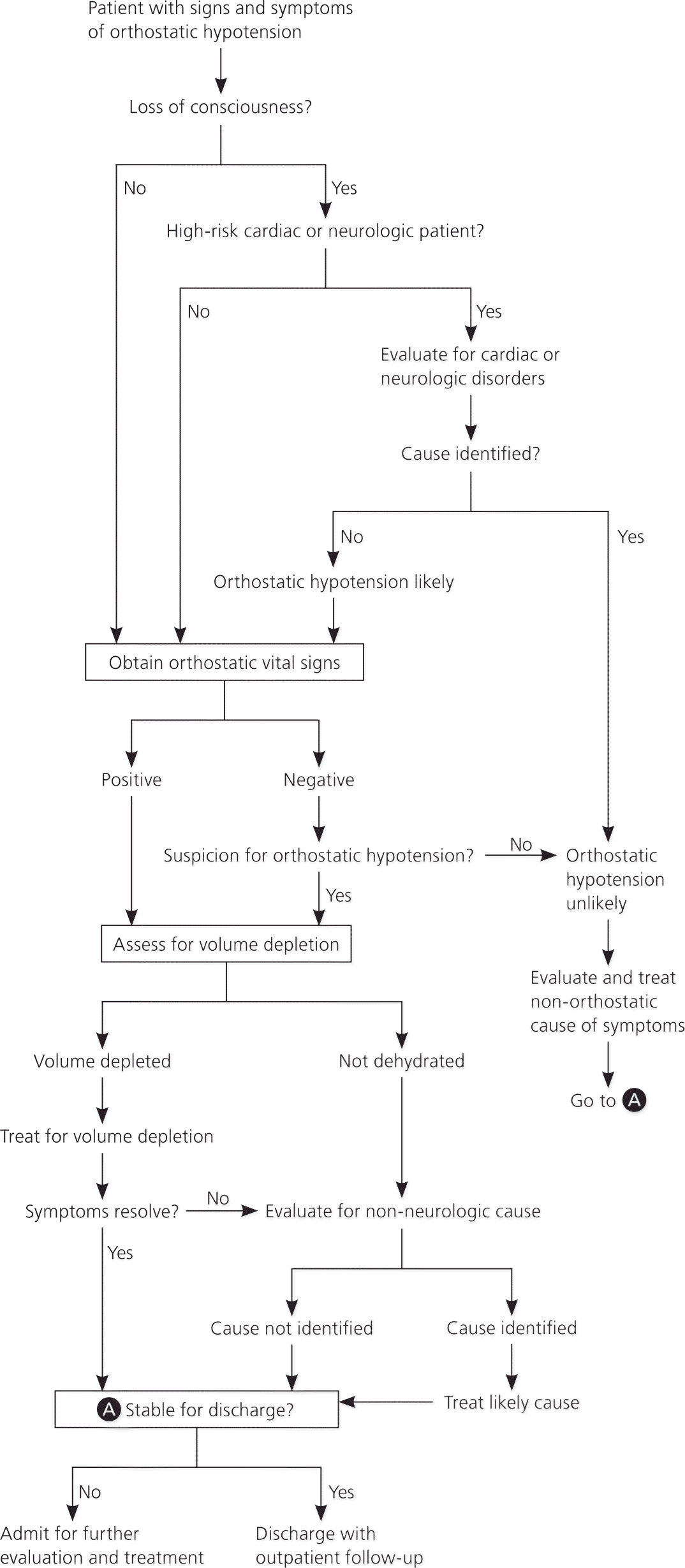
For patients without loss of consciousness, or those who are not considered at high cardiac or neurologic risk despite syncope, the evaluation shifts to rapidly identifying and treating reversible causes. If there is no evidence of intravascular volume depletion, or no response to volume resuscitation, then other causes should be considered. Several laboratory, imaging, and ancillary tests may be indicated (Table 6).7,18,20
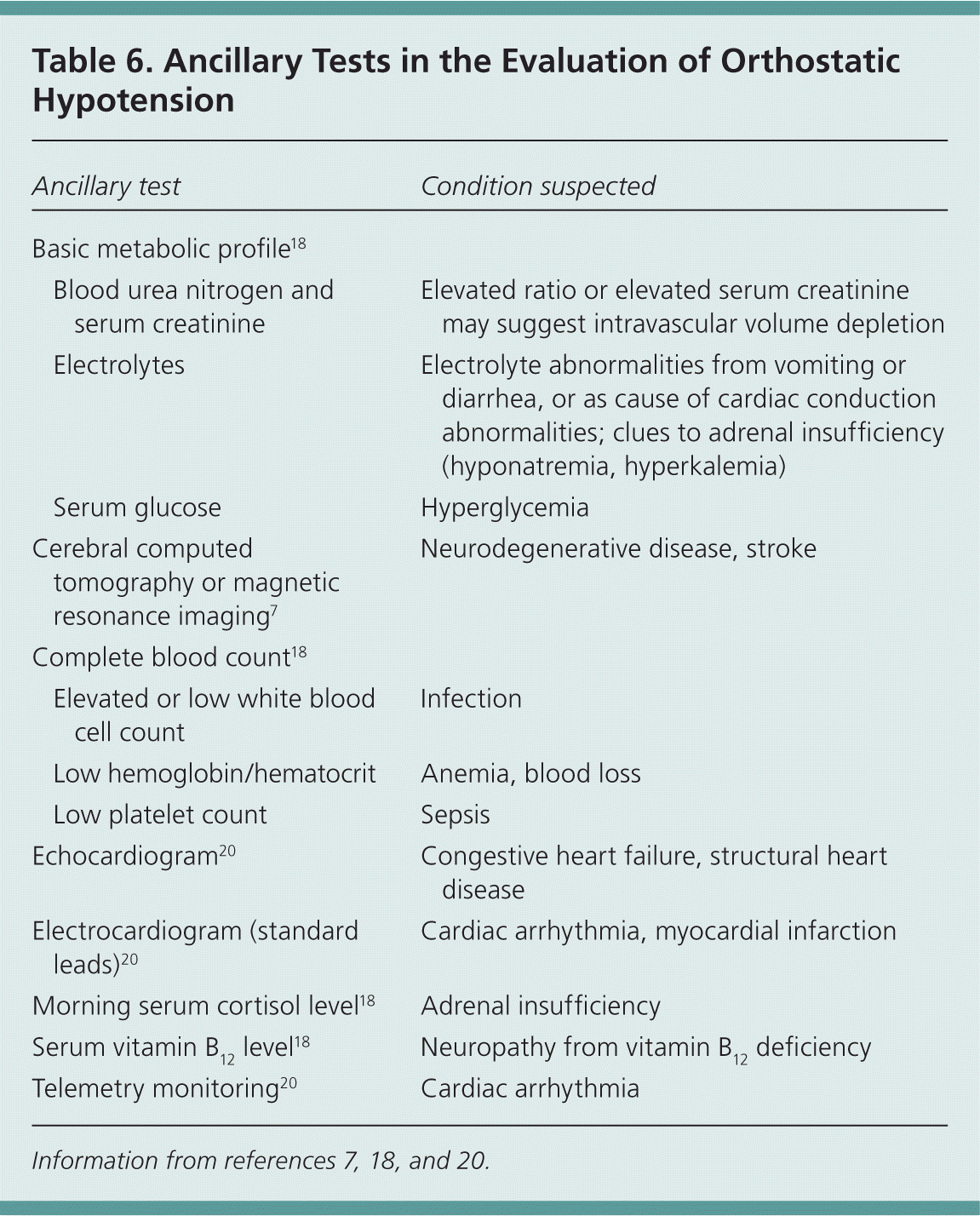
| Ancillary test | Condition suspected | |
|---|---|---|
| Basic metabolic profile18 | ||
| Blood urea nitrogen and serum creatinine | Elevated ratio or elevated serum creatinine may suggest intravascular volume depletion | |
| Electrolytes | Electrolyte abnormalities from vomiting or diarrhea, or as cause of cardiac conduction abnormalities; clues to adrenal insufficiency (hyponatremia, hyperkalemia) | |
| Serum glucose | Hyperglycemia | |
| Cerebral computed tomography or magnetic resonance imaging7 | Neurodegenerative disease, stroke | |
| Complete blood count18 | ||
| Elevated or low white blood cell count | Infection | |
| Low hemoglobin/hematocrit | Anemia, blood loss | |
| Low platelet count | Sepsis | |
| Echocardiogram20 | Congestive heart failure, structural heart disease | |
| Electrocardiogram (standard leads)20 | Cardiac arrhythmia, myocardial infarction | |
| Morning serum cortisol level18 | Adrenal insufficiency | |
| Serum vitamin B12 level18 | Neuropathy from vitamin B12 deficiency | |
| Telemetry monitoring20 | Cardiac arrhythmia | |
OUTPATIENT SETTING
Those who seek evaluation as outpatients are likely to have chronic etiologies of orthostatic hypotension (Figure 3), or they may have been referred for further testing upon discharge from the emergency department or hospital. They may be more likely to present with undifferentiated descriptions of dizziness as a symptom. If possible, potentially contributing medications (Table 18–10 ) should be discontinued and the patient reevaluated. If orthostatic hypotension persists, laboratory testing for underlying causes should include a complete blood count, basic metabolic panel, vitamin B12 level, and morning cortisol (Table 67,18,20 ).7 Orthostatic hypotension is often neurogenic in patients whose history, physical examination, and laboratory testing do not suggest another cause. Magnetic resonance imaging can be used to assess for possible etiologies of neurogenic orthostatic hypotension (Table 7).7 If the cause still is not apparent, autonomic testing may be indicated. The autonomic test most often used is the head-up tilt-table test.
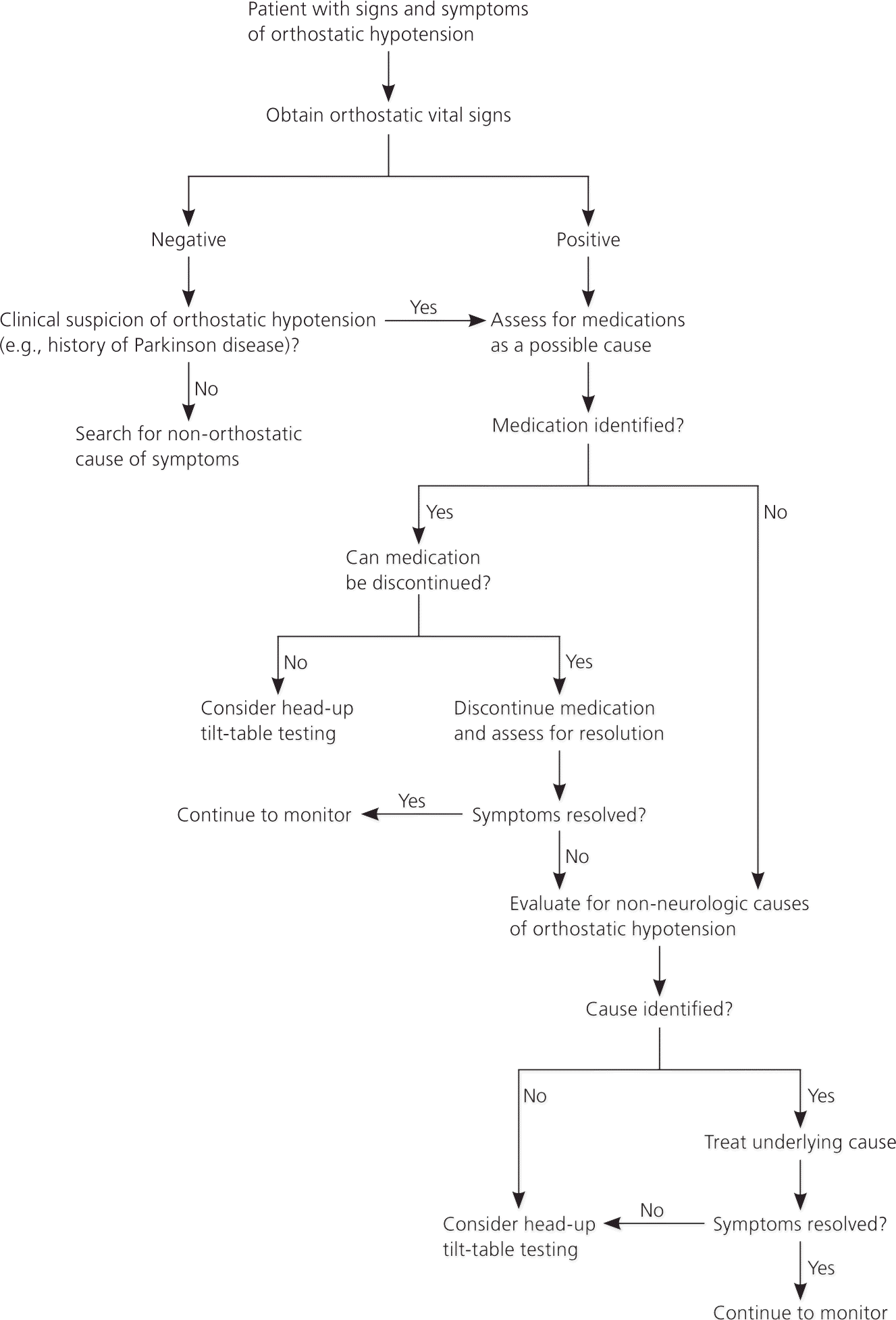
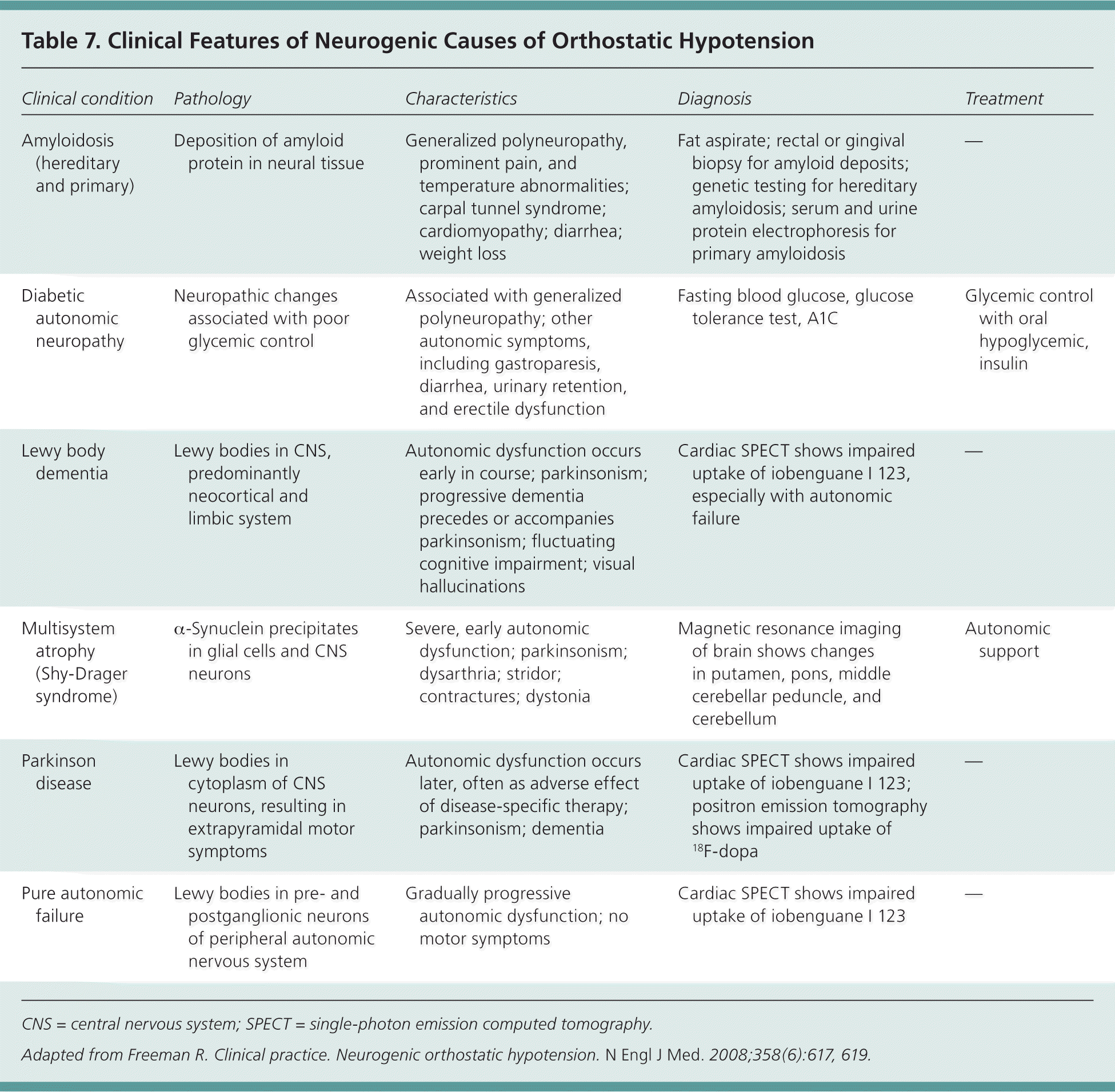
| Clinical condition | Pathology | Characteristics | Diagnosis | Treatment |
|---|---|---|---|---|
| Amyloidosis (hereditary and primary) | Deposition of amyloid protein in neural tissue | Generalized polyneuropathy, prominent pain, and temperature abnormalities; carpal tunnel syndrome; cardiomyopathy; diarrhea; weight loss | Fat aspirate; rectal or gingival biopsy for amyloid deposits; genetic testing for hereditary amyloidosis; serum and urine protein electrophoresis for primary amyloidosis | — |
| Diabetic autonomic neuropathy | Neuropathic changes associated with poor glycemic control | Associated with generalized polyneuropathy; other autonomic symptoms, including gastroparesis, diarrhea, urinary retention, and erectile dysfunction | Fasting blood glucose, glucose tolerance test, A1C | Glycemic control with oral hypoglycemic, insulin |
| Lewy body dementia | Lewy bodies in CNS, predominantly neocortical and limbic system | Autonomic dysfunction occurs early in course; parkinsonism; progressive dementia precedes or accompanies parkinsonism; fluctuating cognitive impairment; visual hallucinations | Cardiac SPECT shows impaired uptake of iobenguane I 123, especially with autonomic failure | — |
| Multisystem atrophy (Shy-Drager syndrome) | α-Synuclein precipitates in glial cells and CNS neurons | Severe, early autonomic dysfunction; parkinsonism; dysarthria; stridor; contractures; dystonia | Magnetic resonance imaging of brain shows changes in putamen, pons, middle cerebellar peduncle, and cerebellum | Autonomic support |
| Parkinson disease | Lewy bodies in cytoplasm of CNS neurons, resulting in extrapyramidal motor symptoms | Autonomic dysfunction occurs later, often as adverse effect of disease-specific therapy; parkinsonism; dementia | Cardiac SPECT shows impaired uptake of iobenguane I 123; positron emission tomography shows impaired uptake of 18 F-dopa | — |
| Pure autonomic failure | Lewy bodies in pre- and postganglionic neurons of peripheral autonomic nervous system | Gradually progressive autonomic dysfunction; no motor symptoms | Cardiac SPECT shows impaired uptake of iobenguane I 123 | — |
Treatment
Acute orthostatic hypotension generally resolves with treatment of the underlying cause. In patients with chronic orthostatic hypotension, pharmacologic and nonpharmacologic treatments may be beneficial. All patients with chronic orthostatic hypotension should be educated about their diagnosis and goals of treatment, which include improving orthostatic blood pressure without excessive supine hypertension, improving standing time, and relieving orthostatic symptoms.21
NONPHARMACOLOGIC
Nonpharmacologic treatment should be offered to all patients initially. If potentially contributing medications cannot be discontinued, then patients should be instructed to take them at bedtime when possible, particularly antihypertensives.7 Patients should avoid large carbohydrate-rich meals (to prevent postprandial hypotension), limit alcohol intake, and ensure adequate hydration.6,22 Patients should be encouraged to keep a symptom diary and avoid identified precipitating factors. Older patients should consume a minimum of 1.25 to 2.50 L of fluid per day to balance expected 24-hour urine losses. Water boluses (one 480-mL glass of tap water in one study and two 250-mL glasses of water in rapid succession in another study) have been shown to increase standing systolic blood pressure by more than 20 mm Hg for approximately two hours.22
Sodium may be supplemented by adding extra salt to food or taking 0.5- to 1.0-g salt tablets. A 24-hour urine sodium level can aid in treatment. Patients with a value of less than 170 mmol per 24 hours should be placed on 1 to 2 g of supplemental sodium three times a day and be reevaluated in one to two weeks, with the goal of raising urine sodium to between 150 and 200 mEq.21 Patients on sodium supplementation should be monitored for weight gain and edema.
Lower-extremity and abdominal binders may be beneficial. A randomized, single-blind controlled study using tilt-table testing demonstrated effective management of orthostatic hypotension by application of lower-limb compression bandages.23
An exercise program focused on improving conditioning and teaching physical maneuvers to avoid orthostatic hypotension has proven to be beneficial.24 Patients should actively stand with legs crossed, with or without leaning forward. Squatting has been used to alleviate symptomatic orthostatic hypotension.24 Other maneuvers include isometric exercises involving the arms, legs, and abdominal muscles during positional changes or prolonged standing.10 Toe raises, thigh contractions, and bending over at the waist are recommended.21
PHARMACOLOGIC
In patients who do not respond adequately to nonpharmacologic therapy for orthostatic hypotension, medication may be indicated.
Fludrocortisone. Fludrocortisone, which is a synthetic mineralocorticoid, is considered first-line therapy for the treatment of orthostatic hypotension. Dosing should be titrated within the therapeutic range until symptoms are relieved, or until the patient develops peripheral edema or has a weight gain of 4 to 8 lb (1.8 to 3.6 kg).9,24 Adverse effects include headache, supine hypertension, and congestive heart failure. Hypokalemia, which is dose-dependent and can appear within one to two weeks of treatment, may occur.9,24 In one study, hypokalemia developed in 24 percent of participants taking fludrocortisone, with a mean onset of eight months.25
Midodrine. Midodrine, a peripheral selective alpha-1-adrenergic agonist, significantly increases standing systolic blood pressure and improves symptoms in patients with neurogenic orthostatic hypotension.26 Patients should not take the last dose after 6:00 p.m. to avoid supine hypertension. Adverse effects include piloerection, pruritus, and paresthesia. Its use is contra-indicated in patients with coronary heart disease, urinary retention, thyrotoxicosis, or acute renal failure. The U.S. Food and Drug Administration has issued a recommendation to withdraw midodrine from the market because of a lack of post-approval effectiveness data.27 Continued approval of the drug is currently under review. Its use generally should be restricted to subspecialists. It is believed to have a synergistic effect when combined with fludrocortisone.
Pyridostigmine (Mestinon). Pyridostigmine is a cholinesterase inhibitor that improves neurotransmission at acetylcholine-mediated neurons of the autonomic nervous system. In a double-blind crossover study, patients were randomized to groups receiving 60 mg of pyridostigmine; 60 mg of pyridostigmine with 2.5 mg of midodrine; 60 mg of pyridostigmine with 5 mg of midodrine; or placebo.28 Compared with the placebo group, treatment groups demonstrated a decreased drop in standing diastolic blood pressure without worsening supine hypertension. Adverse effects include loose stools, diaphoresis, hypersalivation, and fasciculations.24
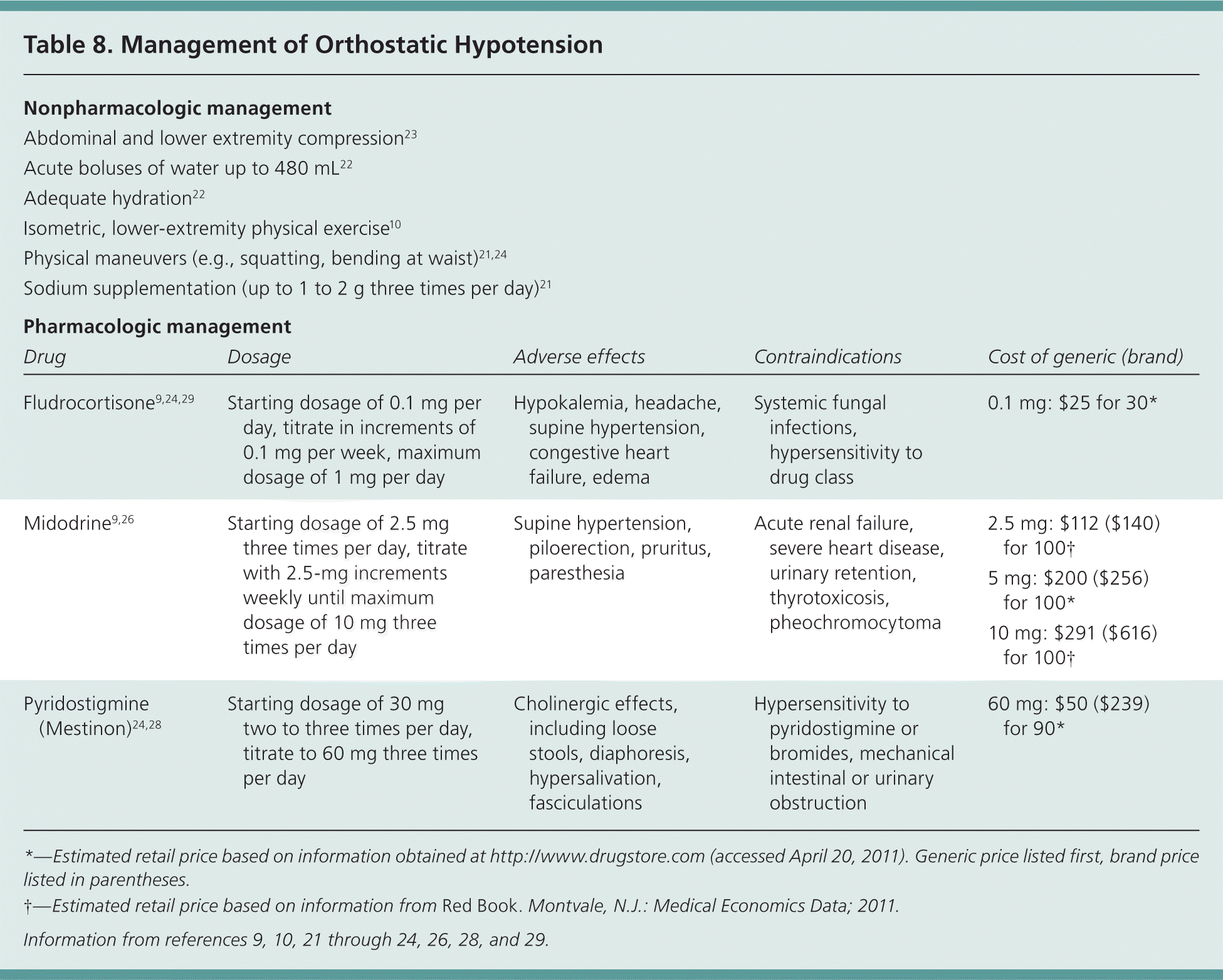
| Nonpharmacologic management | ||||
| Abdominal and lower extremity compression23 | ||||
| Acute boluses of water up to 480 mL22 | ||||
| Adequate hydration22 | ||||
| Isometric, lower-extremity physical exercise10 | ||||
| Physical maneuvers (e.g., squatting, bending at waist)21,24 | ||||
| Sodium supplementation (up to 1 to 2 g three times per day)21 | ||||
| Pharmacologic management | ||||
| Drug | Dosage | Adverse effects | Contraindications | Cost of generic (brand) |
|---|---|---|---|---|
| Fludrocortisone9,24,29 | Starting dosage of 0.1 mg per day, titrate in increments of 0.1 mg per week, maximum dosage of 1 mg per day | Hypokalemia, headache, supine hypertension, congestive heart failure, edema | Systemic fungal infections, hypersensitivity to drug class | 0.1 mg: $25 for 30* |
| Midodrine9,26 | Starting dosage of 2.5 mg three times per day, titrate with 2.5-mg increments weekly until maximum dosage of 10 mg three times per day | Supine hypertension, piloerection, pruritus, paresthesia | Acute renal failure, severe heart disease, urinary retention, thyrotoxicosis, pheochromocytoma | 2.5 mg: $112 ($140) for 100† 5 mg: $200 ($256) for 100* 10 mg: $291 ($616) for 100† |
| Pyridostigmine (Mestinon)24,28 | Starting dosage of 30 mg two to three times per day, titrate to 60 mg three times per day | Cholinergic effects, including loose stools, diaphoresis, hypersalivation, fasciculations | Hypersensitivity to pyridostigmine or bromides, mechanical intestinal or urinary obstruction | 60 mg: $50 ($239) for 90* |
Data Sources: A PubMed search was completed using the MeSH function with the key phrases “orthostatic hypotension,” “evaluation,” and “treatment.” The search included meta-analyses, randomized controlled trials, clinical trials, and reviews. Also searched were the Agency for Healthcare Research and Quality evidence reports, Bandolier, the Canadian Task Force on Preventive Health Care, the Database of Abstracts of Reviews of Effects, the Effective Health Care Program, the Institute for Clinical Systems Improvement, the Cochrane Database of Systematic Reviews, the National Center for Complementary and Alternative Medicine, the National Guideline Clearinghouse database, the U.S. Preventive Services Task Force Web site, Clinical Evidence, and UpToDate. Search date: May 31, 2010.
